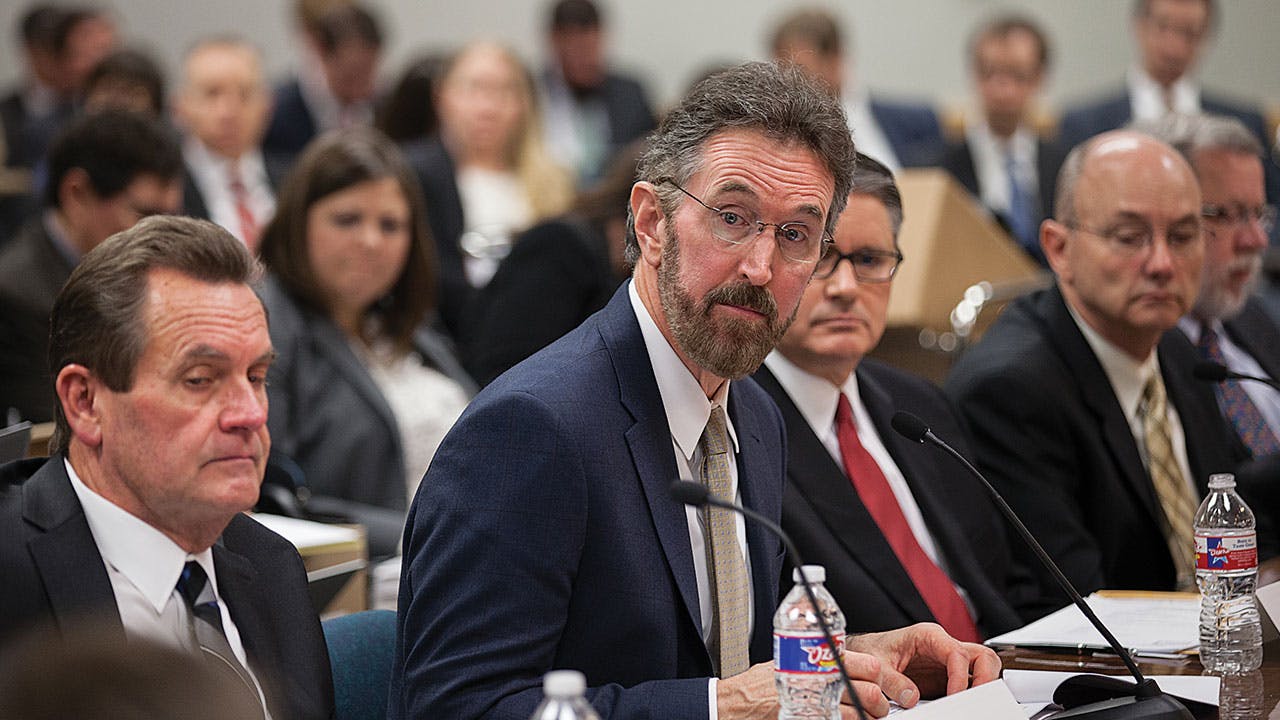The double-wide that Nola Lee lives in sits back from a thin strip of asphalt in northwest Hunt County. Its faded yellow siding needs a coat of paint and its porch railing needs repair, but those are not Lee’s biggest concerns. Worry comes in the form of the monthly electric bill. In January 2015 Lee’s bill was $600, and she kept it from going higher only by turning off the heat for two weeks, even as temperatures dipped into the teens at night. To lessen the burden, Lee’s landlord had bought Christmas gifts for her four children and given her a break on the rent so she could fend off disconnection. “The charges just started climbing,” she says. “I knew something was wrong, but I assumed it was something with the house—the heater, the insulation.” It wasn’t.
About 350 miles west, just outside Big Spring, Nancy Raney shares Lee’s worry. Raney raises alfalfa on a thousand-acre farm that’s been in her family for over a century. About two years ago, her electric bills more than doubled. Running her irrigation system used to cost about $3,000 a month. Now it’s as much as $8,000, which has forced her to raise her prices. Raney would need to sell a bale of hay for $18 or $19 to maintain her profit margin, but she charges $12 and just breaks even. Across the street a neighbor makes money charging only $10 because his electricity costs half as much. The reason? The electric lines running to his house are owned by Oncor, the state’s biggest transmission company. Raney’s—and Lee’s—are owned by Sharyland Utilities, which has the distinction of being the state’s tiniest privately owned transmission company and the most expensive. Sharyland customers pay the highest electricity delivery bills in Texas and some of the highest in the country. “Many of the poorest people in the state have to choose between feeding their children and paying their electric bill,” says state representative Dan Flynn, whose constituents include plenty of Sharyland customers.
Sharyland’s service area is fragmented, covering just 55,000 customers in North Texas, including Hunt County; West Texas, including areas around Midland; and South Texas, in the vicinity of McAllen. In each region, people are caught between inflexible regulatory policy, the breakdown of consumer protections, and the money-making aspirations of Sharyland’s owners, the family of billionaire Ray Lee Hunt. Almost everyone involved agrees Sharyland’s rates are high. But no one has figured out why.
One reason the situation is so confusing is that Texas has an unusually complicated electric power system. In 2002 the state deregulated the market, allowing competition among power plants, which produce the electricity, and retailers, who sell it. Sharyland, though, is involved in the segment of the market that was left behind in that process: the middlemen engaged in transmission and distribution. This part of the system, often referred to as “the grid,” is regulated by the Public Utility Commission of Texas. You might think that a public agency with a mandate to protect customers would put downward pressure on the cost of energy. But in Sharyland’s case, customers say, the PUC has done nothing of the sort. “The reason they exist is to protect the public,” Lee says. “The trust is gone.”

Ray Hunt, a longtime resident of Dallas, is the son of famed wildcatter and bigamist H. L. Hunt, by way of his “second family.” After inheriting one of his father’s oil companies, Hunt broadened the family’s interests into real estate and other businesses. In 2000 Hunt Consolidated Inc. built Sharyland Plantation, a 1,900-home community just south of McAllen and Mission. The development was outside the existing power grid, so the Hunts built their own grid and created their own utility company, Sharyland. To cover the cost of building a grid for so few customers, Sharyland’s rates would have had to be set much higher than those in the surrounding area. But the PUC insisted that Sharyland keep its rates comparable with those of the neighboring grid operator, AEP Texas. After some haggling, Sharyland agreed, hoping the PUC would allow it to raise its rates later and recoup some of its investment. And for a while, Sharyland’s customers paid a reasonable price for electricity.
But the Hunts had bigger ambitions. With all the changes going on in the Texas market, they saw an opportunity to expand and began laying the groundwork for a complex and lucrative ownership structure. Their plan called for creating a real estate investment trust, or REIT, to own transmission lines, substations, and other parts of the grid. REITs were designed for income-producing real estate such as office buildings, shopping malls, and apartment complexes. They work a little like mutual funds in that investors buy interests in them and receive dividends based on the revenue that the REIT collects from its properties. No one had ever used them to hold transmission assets, but both the IRS and the PUC blessed the Hunts’ plan.
In 2010 the Hunts set up their REIT, InfraREIT, and transferred Sharyland’s assets to it. Sharyland then leased those same assets back from InfraREIT. The result is that Sharyland essentially pays InfraREIT “rent”—roughly $151 million last year—on the grid that Sharyland operates and maintains.
What does all this shuffling of ownership do? It enables the Hunts (who own almost 30 percent of InfraREIT) and the other investors to share that rent money, rather than leaving it on Sharyland’s books. In addition to that investment income, the Hunts receive $14 million a year in fees for managing InfraREIT.
But there’s another thing about REITs: if they meet certain conditions—which InfraREIT does—they don’t pay federal corporate income taxes. Instead, REITs pass a portion of their cash flow on to investors, and the investors pay taxes on that money. Yet Sharyland is still allowed, under its PUC-approved rate structure, to collect money from ratepayers to cover a 35 percent tax rate, just as most utilities do.
That arrangement has some people crying foul. “The tax savings ought to be shared with ratepayers,” says Geoffrey Gay, an Austin attorney who is representing Midland in an attempt to stop Sharyland from charging customers even higher rates. “You shouldn’t be charging a thirty-five percent tax to all customers when the utility is never going to have to pay it.”
The Hunts bristle at the notion that they’re engaged in some sort of tax dodge. They have argued in PUC filings that most transmission companies don’t pay taxes at a 35 percent rate even though the companies collect that much from their customers. They also argue that the taxes are being paid, only by investors rather than the company. “The income is still taxed,” says Kirk Baker, InfraREIT’s chairman.
No one at the PUC raised concerns about any of this when Sharyland announced its intent to buy Cap Rock Energy, a group of former electric cooperatives that served the areas around Hunt County and Midland, where Nola Lee and Nancy Raney live. As a decades-old nonprofit cooperative, Cap Rock had never been required to join the competitive market. But soon after the state decided to deregulate, Cap Rock converted to an investor-owned utility, which meant it had to enter the competitive market, spin off its generation and retail operations, and subject its transmission operations to PUC regulation. Company officials argued, however, that Cap Rock needed more time to prepare for the shift and asked for an exemption that would allow it to stay together and grant it great leeway in setting its own transmission rates. The Legislature quickly obliged. (It should be noted that an internal company memo credited then state representative Tom Craddick and his lobbyist daughter, Christi, who worked for Cap Rock, with getting the provision passed.) As a result, Cap Rock’s transmission rates were soon among the highest in the state, sparking an outcry from customers.
After Sharyland announced plans to buy Cap Rock for $221.5 million, the PUC moved to end its special status, and its customers thought they’d finally see lower bills. But that didn’t happen, in part because the PUC did something unexpected.
In 2013 the PUC required Sharyland to adopt cost-based billing, in which each customer pays the actual cost of delivering their electricity. That might sound like common sense, but it has real ramifications. Because delivering energy to far-flung rural customers is expensive, Cap Rock had charged businesses more in order to keep residential rates lower. The PUC’s new instructions upended that arrangement.
Sharyland warned that without commercial customers subsidizing rates, its residential customers were likely to experience “rate shock.” Even so, the PUC approved the new rates—but agreed to implement them in three phases for the Midland and Hunt County areas. The first increase came in 2014, the second in 2015, and the third is pending before the PUC.
As a result, Sharyland’s rates in those areas skyrocketed. In a recent report, the PUC noted that Sharyland’s delivery costs are more than three times as high as those of other transmission companies. “We were screwed over by Cap Rock, and then, when we thought it was going to be better, we wound up even worse off,” says Jan Jones, a Sharyland customer in the Midland area who runs a Facebook page, Sharyland Customers for Fair Rates, that has more than 1,500 members. Sharyland has proposed a credit that would prevent costs from going higher, but that’s small comfort to customers who are already paying too much.
Many Sharyland customers have shopped for new retail providers in hopes of lowering their bills, but found that that would change only their energy charge, not the charge for delivering the energy. Raney, for example, has received bills in which the electricity itself cost 36 percent less than Sharyland’s delivery fee. Normally, delivery is a fraction of the cost of the electricity. “The way they’ve structured these rates has put a lot of families in a lot of hurt,” says Jules Winter, who lives up the road from Lee.
The PUC’s final round of proposed increases includes a plan to bring the rates in South Texas, which have been kept low all these years, in line with the rest of Sharyland’s system. “Consumers down in the McAllen-Mission area are going to get walloped,” says Midland’s attorney, Gay.

All of this likely would have stayed small-town news had the Hunts not set their eyes on a much bigger prize than Cap Rock. In 2007 a group of investors bought Energy Future Holdings, a remnant of the North Texas utility TXU, in a $45 billion leveraged buyout. Seven years later, heavy debt and weak prices for natural gas forced the company to file for bankruptcy. As part of its plan to repay creditors, the company proposed selling its transmission business, Oncor, which serves 10 million customers in North and West Texas, including the residents of Dallas and Fort Worth.
Last year, the Hunts made an offer to buy Oncor for $18 billion, and they wanted to impose on Oncor the same REIT structure they use with Sharyland. Only then did the PUC’s staff—and Oncor itself—begin questioning the deal. Sharyland customers like Winter and Raney traveled to Austin for a PUC hearing to testify against the Hunts’ plan. “We put a little thorn in their saddle,” Raney says. “I think if we hadn’t drawn attention to it, that Oncor deal would have just been rubber-stamped on through.”
And it certainly wasn’t. “The proposed transaction is not in the public interest, and I recommend that the Commission reject the Applicants’ application,” the director of the PUC’s rate regulation division, Darryl Tietjen, wrote in December. Three months later, the PUC approved the Oncor sale, with one significant condition: that the $250 million a year in tax benefits that would come from putting Oncor under the InfraREIT umbrella be used to lower electricity rates. The Hunts pulled out of the negotiations—and in late June sued the PUC.
And just as Sharyland’s unhappy customers cast a public light on the proposed Oncor sale, that deal’s collapse seems to have finally brought attention to their plight. Lawmakers from Sharyland’s service area have peppered the PUC with letters, and the PUC has opened a docket to study customer complaints. Cities like Midland, which had stayed silent during the first two phases of the rate increases, have now intervened. And the Office of Public Utility Counsel, a state agency that is tasked with representing ratepayers, is laser-focused on the issue as well. It noted in a filing last year that a handful of rural Texas cooperatives with small customer bases and wide service areas charge half of what Sharyland charges. “[Sharyland’s] delivery charges are an outlier among both investor-owned utilities and smaller rural electric utilities,” the filing said.
Yet for all the scrutiny, no one has determined if the high rates are caused by the REIT structure, the low customer density of Sharyland’s service area, some other factor, or a combination of all of those. “Somebody has to figure out what the problem is, and nobody’s been able to,” Winter says.
In the meantime, a decision on the final phase of Sharyland’s rate increases probably won’t come before December, by which time the temperatures in Hunt County could be dropping below freezing again. But that won’t be Nola Lee’s problem; in July, looking to get out from under Sharyland’s exorbitant bills, she was planning to move into a new home, served by a different energy carrier. Like a lot of Texans, she’s frustrated with the complexity of an electric system that no one seems to understand. But one thing is clear to her. “Nobody was paying attention,” she says. “And that’s how we got taken advantage of.”








